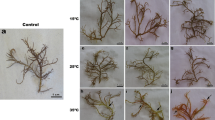Abstract
The brown shrimp, Penaeus aztecus, is subject to dual stresses of environmental hypoxia and contamination of polycyclic aromatic hydrocarbons (PAHs) in the northern Gulf of Mexico. The effects of hypoxia and sedimentary naphthalene, administered alone and in combination, on epidermal activity of N-acetyl-β-glucosaminidase (NAG), a biomarker for molt-interfering effects in P. aztecus, were investigated. It was found that hypoxia and sedimentary naphthalene, when given simultaneously, significantly inhibited epidermal NAG activity, suggesting that these two environmental stressors together can have adverse effects on molting of the brown shrimp. The results of this study also show that sedimentary naphthalene potentiates hypoxia effects on epidermal NAG activity.

Similar content being viewed by others
References
Chang ES, Bruce MJ, Tamone SL (1993) Regulation of crustacean molting: a multihormonal system. Am Zool 33:324–329
Chung AC-K, Durica DS, Clifton SW, Roe BA, Hopkins P (1998) Cloning of crustacean ecdysteroid receptor and retinoid-X receptor gene homologs and elevation of retinoid-X receptor mRNA by retinoic acid. Mol Cell Endocrinol 139:209–227. doi:10.1016/S0303-7207(98)00056-2
Durica DS, Hopkins P (1996) Expression of the genes encoding the ecdysteroid and retinoid receptors in regenerating tissues of the fiddler crab, Uca pugilator. Gene 171:237–241. doi:10.1016/0378-1119(96)00047-9
Lassuy DR (1983) Species profiles: life histories and environmental requirements (Gulf of Mexico)-brown shrimp. U. S. Fish and Wildlife Service, Division of Biological Services. FWS/OBS-82/11.1. U. S. Army Corps of Engineers, TR EL-82-4
Peachey RBJ (2003) Tributyltin and polycyclic aromatic hydrocarbon levels in Mobile Bay, Alabama: a review. Mar Pollut Bull 46:1365–1371. doi:10.1016/S0025-326X(03)00373-4
Rabalais NN, Turner RE, Dortch Q, Justic D, Bierman VJ Jr, Wiseman WJ Jr (2002) Nutrient-enriched productivity in the northern Gulf of Mexico: past, present and future. Hydrobiologia 475/476:39–63. doi:10.1023/A:1020388503274
Robertson L, Bray W, Leung-Trujillo J, Lawrence A (1987) Practical mol staging of Penaeus setiferus and Penaeus stylirostris. J World Aquacul Soc 18:180–185. doi:10.1111/j.1749-7345.1987.tb00437.x
Seidman ER, Lawrence AL (1985) Growth, feed digestibility, and proximate body composition of juvenile Penaeus vannamei and Penaeus monodon grown at different dissolved oxygen levels. J World Maricul Soc 16:333–346
Wade TL, Atlas EL, Brooks JM, Kennicutt MC, Fox RG, Sericano J, Garcia-Romero B, DeFreitas D (1988) NOAA Gulf of Mexico status and trends program: trace organic contaminant distribution in sediments and oysters. Estuaries 11:171–179. doi:10.2307/1351969
Walker ND, Rabalais NN (2006) Relationships among satellite chlorophyll a, river inputs, and hypoxia on the Louisiana continental shelf, Gulf of Mexico. Estuar Coast 29:1081–1093
Ye R, Zou E (2008) Hypoxia does not promote naphthalene bioaccumulation in the brown shrimp, Penaeus aztecus. Mar Pollut Bull 57:307–312. doi:10.1016/j.marpolbul.2008.02.034
Zou E (2005) Impacts of xenobiotics on crustacean molting: the invisible endocrine disruption. Integr Comp Biol 45:33–38. doi:10.1093/icb/45.1.33
Zou E, Bonvillain R (2004) Chitinase activity in the epidermis of the fiddler crab, Uca pugilator, as an in vivo screen for molt-interfering xenobiotics. Comp Biochem Physiol 139C:225–230
Zou E, Fingerman M (1999a) Chitobiase activity in the epidermis and hepatopancreas of the fiddler crab Uca pugilator during the molting cycle. Mar Biol 133:97–101. doi:10.1007/s002270050447
Zou E, Fingerman M (1999b) Patterns of N-acetyl-β-glucosaminidase isoenzymes in the epidermis and hepatopancreas and induction of N-acetyl-β-glucosaminidase activity by 20-hydroxyecdysone in the fiddler crab, Uca pugilator. Comp Biochem Physiol 124C:345–349
Zou E, Fingerman M (1999c) Effects of estrogenic agents on chitobiase activities of the epidermis and hepatopancreas of the fiddler crab, Uca pugilator. Ecotoxicol Environ Saf 42:185–190. doi:10.1006/eesa.1998.1740
Zou E, Fingerman M (1999d) Effects of exposure to diethyl phthalate, 4-tert-octylphenol, and 2,4,5-trichlorobiphenyl on activity of chitobiase in the epidermis and hepatopancreas of the fiddler crab, Uca pugilator. Comp Biochem Physiol 122C:115–120
Zou E, Stueben B (2006) Acute exposure to naphthalene reduces oxyregulating capacity of the brown shrimp, Penaeus aztecus, subjected to progressive hypoxia. Mar Biol 149:1411–1415. doi:10.1007/s00227-006-0294-4
Acknowledgments
This study was sponsored by the US National Oceanic and Atmospheric Administration (NOAA) and the US Geological Survey (USGS) through the Long-term Estuary Assessment Group (LEAG).
Author information
Authors and Affiliations
Corresponding author
Rights and permissions
About this article
Cite this article
Zou, E. Effects of Hypoxia and Sedimentary Naphthalene on the Activity of N-acetyl-β-Glucosaminidase in the Epidermis of the Brown Shrimp, Penaeus aztecus . Bull Environ Contam Toxicol 82, 579–582 (2009). https://doi.org/10.1007/s00128-008-9619-y
Received:
Accepted:
Published:
Issue Date:
DOI: https://doi.org/10.1007/s00128-008-9619-y




